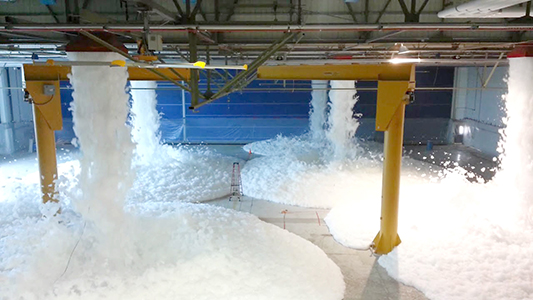 We have all seen the stories in the news, presentations at conferences and articles in industry magazines — the dangers associated with long-term exposure to Per- and Polyfluoroalkyl Substances. Also known as PFAS, this group of chemicals includes Perfluorooctane Sulfonate (PFOS) and Perfluorooctanoic Acid (PFOA). These synthetic chemicals currently exist in products we are exposed to every day as they are effective in repelling water and oil. Products such as nonstick coatings, cleaning products, waxes, polishes and paints for various uses including some cookware, clothing, furniture fabrics and carpets. The EPA notes these “…chemicals are very persistent in the environment and in the human body — meaning they don’t break down and they can accumulate over time. There is evidence that exposure to PFAS can lead to adverse human health effects.”
We have all seen the stories in the news, presentations at conferences and articles in industry magazines — the dangers associated with long-term exposure to Per- and Polyfluoroalkyl Substances. Also known as PFAS, this group of chemicals includes Perfluorooctane Sulfonate (PFOS) and Perfluorooctanoic Acid (PFOA). These synthetic chemicals currently exist in products we are exposed to every day as they are effective in repelling water and oil. Products such as nonstick coatings, cleaning products, waxes, polishes and paints for various uses including some cookware, clothing, furniture fabrics and carpets. The EPA notes these “…chemicals are very persistent in the environment and in the human body — meaning they don’t break down and they can accumulate over time. There is evidence that exposure to PFAS can lead to adverse human health effects.”
PFAS chemicals are present in some fire-fighting foams, such as Aqueous Film Forming Foam (AFFF). However, we have also seen a lot of misinformation circulating about which fire suppression systems contain PFAS and, as such, we see confusion as to what options are currently available for fire suppression. For example, in a recent news story describing the dangers of PFAS contained in firefighting foam we noted the accompanying video was of a fire suppression system which does not include a PFAS chemical. There is clearly a lot of confusion out there coupled with a current lack of equivalent, alternative systems — and this is where FSB can help.
FSB is an architectural and engineering firm with multiple specialty facility types, among those are aircraft hangars which commonly include foam suppression systems to combat the potential for aircraft fuel fires and other aircraft related fire risks. We will dive into this topic and explore the requirements, options and considerations before returning to discuss alternative systems given what we know about the human health risks associated with PFAS in some aircraft hangar fire suppression systems.
How prescriptive are the applicable codes for hangar fire suppression, and what are they?
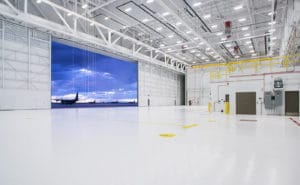 The applicable codes and standards are very prescriptive, and they thoroughly govern the design, construction and performance of aircraft hangar fire suppression systems. Among these are the International Building Code (IBC), International Fire Code (IFC), National Fire Protection Association (NFPA) 409, NFPA 11, State/Local requirements, and any Owner adopted standards such as Factory Mutual (FM) Global (including FMG Data Sheet 7-93) or Unified Facilities Criteria (UFC) 4-211-01 for the Department of Defense. These documents cover all types of aircraft hangars categorized by their use — such as storage and light maintenance, heavy maintenance, manufacturing, fuel cell, wash bays, corrosion control and paint hangars. Each aircraft hangar function comes with unique, varying risks unique to the type of maintenance, presence of aviation fuel or other chemicals and size of hangars. NFPA 409 also allows other equivalent fire suppression systems, as long as sufficient technical documentation is submitted to the authorities, and the alternative system is approved.
The applicable codes and standards are very prescriptive, and they thoroughly govern the design, construction and performance of aircraft hangar fire suppression systems. Among these are the International Building Code (IBC), International Fire Code (IFC), National Fire Protection Association (NFPA) 409, NFPA 11, State/Local requirements, and any Owner adopted standards such as Factory Mutual (FM) Global (including FMG Data Sheet 7-93) or Unified Facilities Criteria (UFC) 4-211-01 for the Department of Defense. These documents cover all types of aircraft hangars categorized by their use — such as storage and light maintenance, heavy maintenance, manufacturing, fuel cell, wash bays, corrosion control and paint hangars. Each aircraft hangar function comes with unique, varying risks unique to the type of maintenance, presence of aviation fuel or other chemicals and size of hangars. NFPA 409 also allows other equivalent fire suppression systems, as long as sufficient technical documentation is submitted to the authorities, and the alternative system is approved.
That’s a lot of criteria — I have 5 minutes — what do they require?
Most commercial and Department of Defense hangars for larger aircraft fall into the NFPA 409 Group I category, meaning the hangar doors are over 28 feet tall or a single fire area is more than 40,000 square feet. NFPA 409 has additional categories for smaller hangars (Group II and III), membrane hangars (Group IV) and hangars for painting aircraft and hangars for unfueled aircraft.
NFPA 11, Standard for Low, Medium and High Expansion Foam, identifies several types of foam concentrates which may be used to extinguish hydrocarbon fuels. Of these foams, AFFF and HEF have been the most commonly used in aircraft hangars. NFPA 409 identifies several options for Group I aircraft hangar fire suppression, summarized below:
- Option 1 is a Foam-Water Deluge System. This system utilizes low expansion foam (max 20:1) discharged uniformly from open sprinklers in the hangar overhead. For hangars housing wide body aircraft, the wings block the application of foam directly below and a supplementary protection system using oscillating (or fixed) monitor-nozzles discharging low expansion foam must be provided. Foam can either be AFFF (aqueous film forming foam) or a fluorine-free synthetic foam, which is becoming more common as the foam concentrates become listed with proportioning and discharge devices.
- Option 2 is a combination of water-only overhead sprinklers and an automatic low-level low expansion foam (expansion ratio up to 20:1) system. This system uses water-only from a wet pipe or preaction sprinkler system plus full-floor coverage oscillating monitor nozzles or grate nozzles located in floor trenches. Foam-water solution creates a film over the flaming pool fire, while the fuel and foam-water solution flows by gravity into drainage trenches. Typically, this is also an AFFF system.
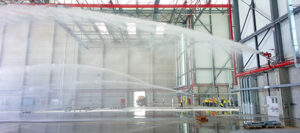
Oscillating (Wall) Nozzles 
Nozzles (In Floor) Trenches - Option 3 is a combination of water-only overhead sprinklers and an automatic low-level high expansion foam (HEF) system, with a maximum expansion ratio of 1000:1. This system uses water-only from an overhead wet pipe or preaction sprinkler system plus full-floor coverage from high expansion foam generators covering the entire hangar floor discharging at a rate of 3 cfm/sf. HEF builds up on the hangar floor to a depth of at least three feet, and often, much deeper than that.
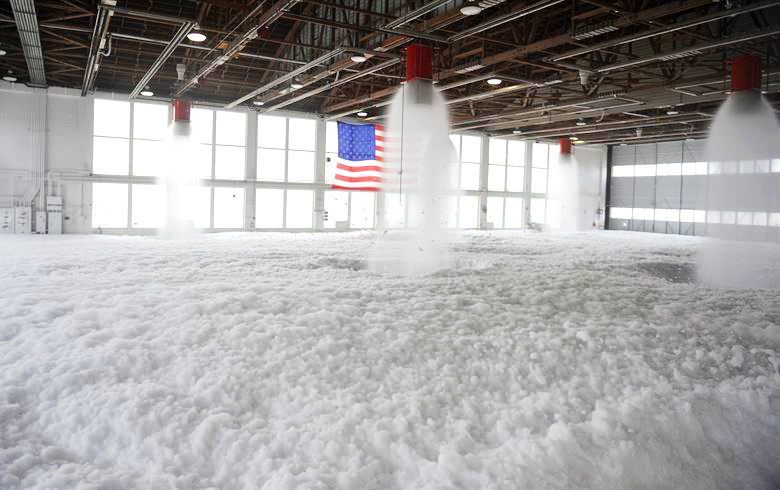 So… which fire suppression systems are most commonly utilized and how do they work?
So… which fire suppression systems are most commonly utilized and how do they work?
Most commercial hangars are designed with high expansion foam suppression systems. HEF systems for commercial hangars must comply with NFPA 409, per IBC requirements. HEF is produced by foam generators typically hung at the ceiling level. A foam-water solution flows into the generator and through a series of nozzles, while a sidestream flow operates a water motor that spins a fan to induce air into the bubbles as it discharges. It is preferred for foam to discharge near, but not onto, the aircraft. NFPA 409 requires air from outside the hangar to supply foam generators, therefore relief air vents are required to offset the outside air introduced. Per NFPA 409, HEF is a local application, using NFPA 11 equations including sprinkler breakdown factor. Leakage and shrinkage factors do not apply.
 Within the Department of Defense, most Air Force, Air Force Reserves and Air National Guard hangars utilize HEF, however the DoD permits air from inside the hangar to be used to make foam, thus removing the requirement for roof vents and relief vents. In these designs a total submergence application is utilized, applying leakage and shrinkage factors to the discharged foam quantity, as well as additional timed coverage criteria. Since the DoD uses an inductor type proportioning system and atmospheric tank, water supply pressures are much higher than for a typical commercial hangar.
Within the Department of Defense, most Air Force, Air Force Reserves and Air National Guard hangars utilize HEF, however the DoD permits air from inside the hangar to be used to make foam, thus removing the requirement for roof vents and relief vents. In these designs a total submergence application is utilized, applying leakage and shrinkage factors to the discharged foam quantity, as well as additional timed coverage criteria. Since the DoD uses an inductor type proportioning system and atmospheric tank, water supply pressures are much higher than for a typical commercial hangar.
Aqueous film forming foam (AFFF) systems are most common in commercial hangars with an existing water supply, as the cost of the fire pumps, water storage tank, and retention of discharged foam has already been incurred. If trenches at approximately 50 feet on center throughout the hangar are provided, grate nozzles can be provided to discharge low expansion foam over the hangar floor. Prior to 2020, Navy and Marine hangars commonly used low expansion AFFF, along with the inductor type proportioning system identified above for the Air Force.
What are the pros and cons of these two commonly used systems?
Both systems are effective in fighting hydrocarbon fires in aircraft hangars. Since high expansion foam is dropped from the ceiling, a hangar with fixed aircraft positions is preferred in order to not drop foam directly on the aircraft. Low level foam systems, such as AFFF, permit a flexible aircraft parking arrangement since the foam discharges at the floor from regularly spaced trenches. Costs of each system vary depending upon the area and height of the hangar, type of hangar, availability of water (pressure and volume), site/infrastructure factors and maintenance costs — an experienced firm, such as FSB can help walk you through these decisions during the design of your hangar.
High expansion foam (HEF) systems have been associated with damage to aircraft as the foam discharge of three cubic feet per minute builds up across the hangar floor until the system is shut off. It is all too common to see HEF engulf an aircraft in foam.
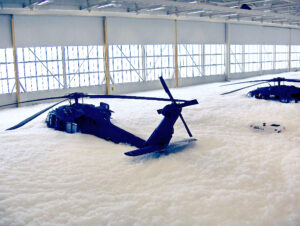 As a result, hangar downtime is increased as the aircraft skin must be rinsed, and any damaged aircraft components must be replaced or repaired. In favorable conditions, HEF on the hangar floor may dissipate overnight for cleanup the following day using a squeegee and rinse or using a floor vacuum dryer unit. Additionally, HEF discharge is likely to affect areas adjoining the hangar bay, including the exterior, due to foam creep — and any equipment in the hangar will be submerged with foam. Most current HEF hangars are now provided with foam start/stop stations and flow control valves, so the flow of an unwanted discharge can be stopped manually after it has started.
As a result, hangar downtime is increased as the aircraft skin must be rinsed, and any damaged aircraft components must be replaced or repaired. In favorable conditions, HEF on the hangar floor may dissipate overnight for cleanup the following day using a squeegee and rinse or using a floor vacuum dryer unit. Additionally, HEF discharge is likely to affect areas adjoining the hangar bay, including the exterior, due to foam creep — and any equipment in the hangar will be submerged with foam. Most current HEF hangars are now provided with foam start/stop stations and flow control valves, so the flow of an unwanted discharge can be stopped manually after it has started.
HEF systems may have higher maintenance costs associated with variable speed pump controllers or specialized pressure regulating valves due to the use of the inductor system, offset by lower maintenance costs for atmospheric foam concentrate tanks. Higher construction costs may also be experienced due to high pressure piping, pumps and equipment (or variable speed fire pump controllers), HEF generators, and pressure regulating valves, which are partly offset by lower required flow rates, smaller fire pumps and atmospheric storage tanks. Commercial hangars can generally be provided without the need to utilize pressures over 175 psi, if conscious attention is given to achieve this goal. Other maintenance considerations for HEF systems are access from the floor to high bay equipment, and access to roof mounted intake vents for commercial hangars. HEF benefits include lower water (volume) demand, smaller water storage tanks and fire pumps and fewer floor trenches when compared to low expansion foam.
 Aqueous film forming foam (AFFF) is discharged from flush nozzles in the trench grates and foam discharge is limited to approximately two feet above the hangar floor (note: misting may exist higher). The system is functional, even when one or more grate nozzles are blocked, such as by aircraft gear, parts or ancillary equipment. The downtime of the hangar is minimized following a foam discharge as the low expansion foam flows into trench drainage and containment system with minimal cleanup. The floor may be cleaned with a water rinse and squeegee. Since the foam is low level, aircraft are not engulfed in foam and would not be expected to experience damage. AFFF discharge does not typically affect areas adjoining the hangar bay, as the grate nozzles are positioned to discharge away from walls and doors, minimizing the chance of foam discharge affecting wall mounted equipment, and minimizing the effect above the two- or three-foot level. AFFF monitor nozzles have similar characteristics when compared to grate nozzles, however care to maintain a free discharge without obstructions is the primary concern with this system.
Aqueous film forming foam (AFFF) is discharged from flush nozzles in the trench grates and foam discharge is limited to approximately two feet above the hangar floor (note: misting may exist higher). The system is functional, even when one or more grate nozzles are blocked, such as by aircraft gear, parts or ancillary equipment. The downtime of the hangar is minimized following a foam discharge as the low expansion foam flows into trench drainage and containment system with minimal cleanup. The floor may be cleaned with a water rinse and squeegee. Since the foam is low level, aircraft are not engulfed in foam and would not be expected to experience damage. AFFF discharge does not typically affect areas adjoining the hangar bay, as the grate nozzles are positioned to discharge away from walls and doors, minimizing the chance of foam discharge affecting wall mounted equipment, and minimizing the effect above the two- or three-foot level. AFFF monitor nozzles have similar characteristics when compared to grate nozzles, however care to maintain a free discharge without obstructions is the primary concern with this system.
A grate nozzle AFFF system has lower maintenance requirements due to no moving parts in the grate nozzle. The need for high pressure systems is greatly reduced, minimizing the need for maintenance of pressure regulating stations or variable speed drives. Lower construction costs are often associated with standard pressure piping, pumps and equipment, however the standard operating pressures must be maintained by design. These lower system costs, however, will likely be offset with the significant additional infrastructure costs such as floor trenches, higher water demand, larger water storage tanks, foam retention system and foam disposal.
Which foams contain PFAS, PFOS, PFOA?
The most significant negative to AFFF is the existence of chemicals classified as PFAS (PFOS and/or PFOA). While these chemicals exist in varying quantities depending upon the formulation, even very small amounts of exposure over time or in our food/water supply can have harmful human impacts, as noted by the EPA and other agencies.
It should be noted here that HEF formulations, available for use today, do not contain chemicals classified as either PFOS or PFOA. And this takes us back to the news stories talking about the health issues associated with PFAS but showing a HEF foam system discharging a chemical that does not contain PFAS. It’s important that we understand the chemical differences which exist in these foam systems.
As a result of toxic fluorine containing compounds in AFFF, the National Defense Authorization Act (NDAA) released in December 2019, required all AFFF to be removed from all DoD uses, fixed and mobile, by 2024 (note: a waiver may extend this to 2026). This should also be considered a caution for commercial hangar AFFF systems. These changes due to health implications of fluorinated compounds are required to protect the health of firefighters and citizens whose health and food/water supplies might be affected by the fluorinated compounds found in AFFF.
As a result of toxic fluorine containing compounds in AFFF, the National Defense Authorization Act (NDAA) released in December 2019, required all AFFF to be removed from all DoD uses, fixed and mobile, by 2024
This is a huge and immediate impact to new and existing hangars, are there any alternatives? What are the available options for a fire suppression system with the benefits of a low-level foam discharge?
Initially, manufacturers reformulated a C6 AFFF, which is much better environmentally than the old C8 AFFF, but this still cannot be used per the NDAA. The NDAA requirements reflect that even though the quantity of PFAS in AFFF concentrate has been greatly reduced by reformulating the foam concentrate from an 8 carbon chain to a 6 by the industry, that change is not sufficient for DoD projects going forward. There are fluorine-free foams available, but most are not film forming or not yet fully tested or proven. Or possibly, you need to consider the high expansion foam system. But for the purposes of this article, lets focus on the status and future of low-level system and potential equivalents.

Concerns with known synthetic fluorine-free foams include:
- Degradation and flammable mixture when mixed with fuel, and no film to prevent mixing
- Higher chemical Biological Oxygen Demand if released to aquatic environment
- Increased hydrocarbon surfactant in the concentrate increases aquatic toxicity
- Concentrate is anticipated to be more expensive than AFFF
Synthetic fluorine-free foams are relatively new; however, some manufacturers have been providing synthetic foams without fluorine for several years. Performance of these foams vary significantly and as such, approval of these foams can vary depending upon the authority having jurisdiction until they are fully listed.
Perhaps most promising in the world of synthetic fluorine-free foams is the ongoing research being performed by several manufacturers of AFFF concentrate with currently listed AFFF equipment. Experimentation is being conducted using synthetic foams with the grate nozzles, oscillating monitor nozzles and open sprinklers; and while these are in various stages of being listed together, we are hearing a target date of fall 2020. Ideally, the goal is to have the same hydraulics, and just replace proportioners, but the reality is that higher application rates along with a higher proportioning rate (6% vs. 3%) may be required. As these synthetic foams are listed with existing proportioning and discharge equipment, they may require changes to the piping system.
Reportedly, several manufacturers are working on the development of alternatives; but at the time of this writing, test results do not reach AFFF performance. Additionally, for DoD hangars, current synthetic foams do not meet MilSpec performance criteria and it is anticipated this criteria will receive modification in 2020 as AFFF is no longer an acceptable foam concentrate per the NDAA.
NFPA 409 supports low expansion foam and does not differentiate between AFFF and synthetic fluorine-free foams. NFPA 11 does not address synthetic fluorine-free foams, except in the category of “other”. Changes to include synthetic fluorine-free foams are anticipated to be addressed in the next revision of NFPA 11, which was in progress as of spring 2020.
Is there an “out-of-the-box” alternative?
Many in the industry have expressed concern with exchanging one chemical with another. This could mean substituting a chemical with a known environmental hazard with a chemical with a, perhaps, unknown environmental hazard. Some in industry point to diligent operational and safety practices in aircraft hangars which have resulted in no known reports of an HEF or AFFF system being triggered to extinguish an unintentional event, coupled with damage to aircraft and facilities from accidental foam discharges, to question the reason for the code required chemical/foam fire suppression system.
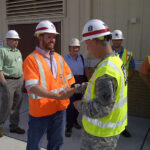 While still in the early stages, there is a non-chemical aircraft hangar fire protection system aimed at mitigating fires from aircraft fuel spills. SafeSpill flooring is not a foam fire suppression system and is still in the process of being recognized as an approved alternative. This proprietary system sits on top of the hangar floor under the aircraft to collect fuel spills by compartmentalizing the fuel spill, directing it into channels which are flushed with water. NFPA 409 does not currently recognize flooring systems as acceptable fire suppression, however if proper justification is provided, it may be acceptable to your Authority Having Jurisdiction. Being a non-foam solution, NFPA 11 would not be applicable, however portions of NFPA 30 may be appropriately applied. Impacts to new and existing facilities would vary depending on your situation and may require an increase to overhead sprinkler density since no foam suppression is provided. The system itself would reduce the overall water demand for most hangars — and consideration will need to be given to maintaining the system along with containment and disposal.
While still in the early stages, there is a non-chemical aircraft hangar fire protection system aimed at mitigating fires from aircraft fuel spills. SafeSpill flooring is not a foam fire suppression system and is still in the process of being recognized as an approved alternative. This proprietary system sits on top of the hangar floor under the aircraft to collect fuel spills by compartmentalizing the fuel spill, directing it into channels which are flushed with water. NFPA 409 does not currently recognize flooring systems as acceptable fire suppression, however if proper justification is provided, it may be acceptable to your Authority Having Jurisdiction. Being a non-foam solution, NFPA 11 would not be applicable, however portions of NFPA 30 may be appropriately applied. Impacts to new and existing facilities would vary depending on your situation and may require an increase to overhead sprinkler density since no foam suppression is provided. The system itself would reduce the overall water demand for most hangars — and consideration will need to be given to maintaining the system along with containment and disposal.
If and when approved, this flooring collection system still may not be an appropriate alternative depending on the type of aircraft maintenance being performed and the requirements of the maintenance personnel in that facility. Additionally, the flooring system may not be beneficial in a paint or depaint facility; in these cases, the hangar owner should seriously consider using NFPA 409 for hangars housing unfueled aircraft.
Given the approved fire suppression systems available today, what should we consider?
For new commercial hangars, consider HEF systems and avoid installing new AFFF systems, when possible. Consider alternatives such as HEF where AFFF was used in the past. Consider fluorine-free foam for hand hose stations. Consider fluorine-free foams for overhead deluge sprinklers, monitor nozzles and even grate nozzle systems when they are confirmed to be listed with the discharge devices. Watch for water mist and compressed air foams.
Check back with FSB from time to time to get information on the latest developments during this period of significant change in hangar fire suppression systems.
Are there any recommended references, if I would like to read more?
Absolutely, check out these additional references linked below:
iccsafe.org/products-and-services/i-codes/2018-i-codes/ibc/
up.codes/building-codes-online
wbdg.org/ffc/dod/unified-facilities-criteria-ufc
fmglobal.com/research-and-resources/fm-global-data-sheets
chemguard.com/about-us/documents-library/foam-info/general.htm
nctcog.org/nctcg/media/Transportation/Committees/ATAC/2019/ATAC_November-2019-Presentations.pdf
nfpa.org/409
sfpe.org/page/2013_Q1_3
Author Bios:
 Among the top 1 percent of fire suppression professionals in the U.S., Liane Ozmun has worked on more than 100 flightline facilities for the DoD and commercial aviation industry. Liane is charged with seeing the big picture — looking at fire suppression and alarm systems, egress issues, control panels and the myriad other details necessary to ensure the safety of each building and its occupants, both human and mechanical. Liane has nearly 40 years of expertise on projects ranging from commercial facilities across the country to fire protection systems to safeguard military assets, such as the Air Force One fleet.
Among the top 1 percent of fire suppression professionals in the U.S., Liane Ozmun has worked on more than 100 flightline facilities for the DoD and commercial aviation industry. Liane is charged with seeing the big picture — looking at fire suppression and alarm systems, egress issues, control panels and the myriad other details necessary to ensure the safety of each building and its occupants, both human and mechanical. Liane has nearly 40 years of expertise on projects ranging from commercial facilities across the country to fire protection systems to safeguard military assets, such as the Air Force One fleet.
 Gene Brown has more than twenty years’ experience developing and managing a wide variety of government projects throughout the United States. His passion for the architectural engineering profession can be seen in his client-centered focus and his involvement in education. Through authorship of technical papers, industry articles, design criteria and industry specifications coupled with course instruction and serving as an industry resource, Gene enjoys advancing the collective knowledge base and guiding his client’s projects to maximize their potential.
Gene Brown has more than twenty years’ experience developing and managing a wide variety of government projects throughout the United States. His passion for the architectural engineering profession can be seen in his client-centered focus and his involvement in education. Through authorship of technical papers, industry articles, design criteria and industry specifications coupled with course instruction and serving as an industry resource, Gene enjoys advancing the collective knowledge base and guiding his client’s projects to maximize their potential.
